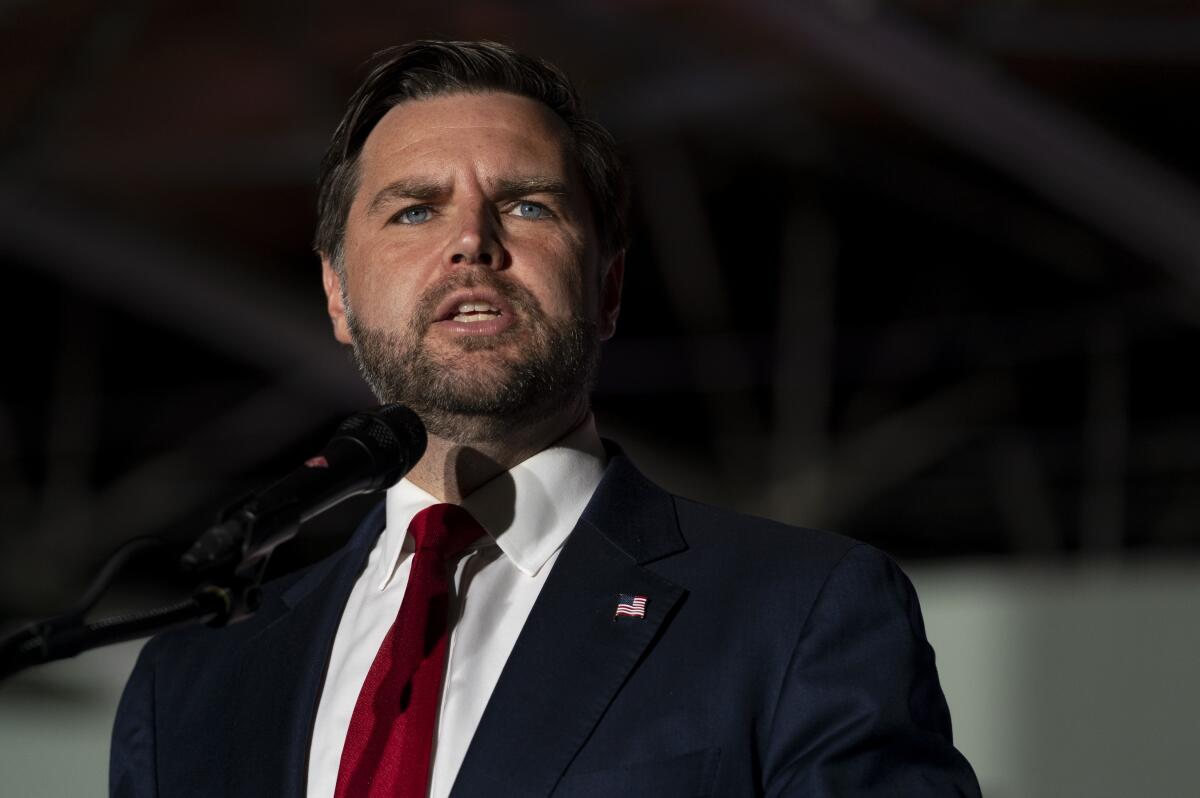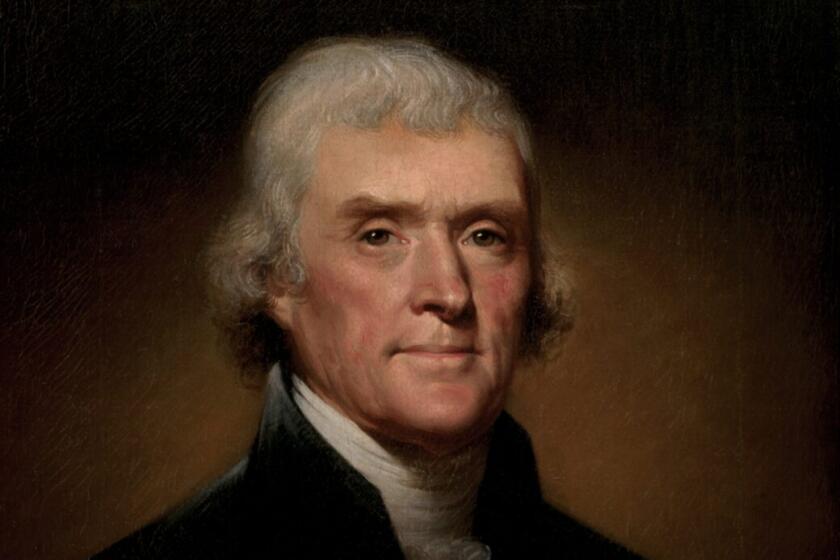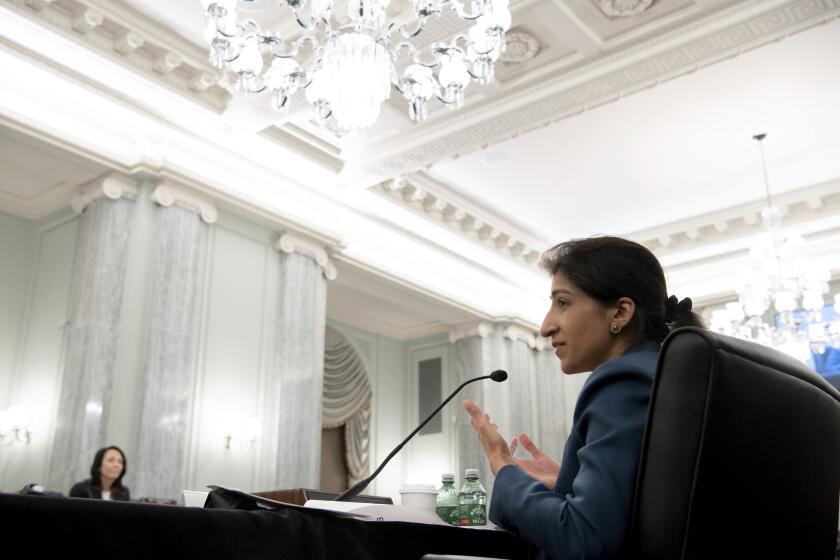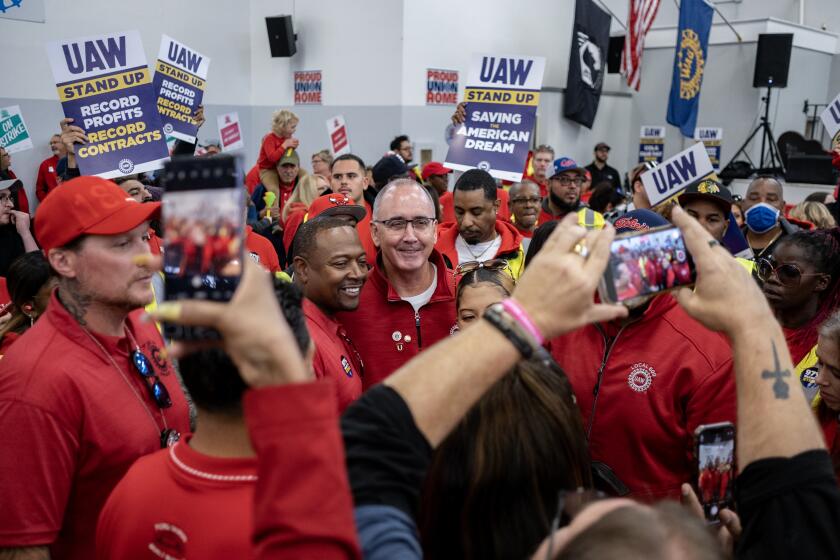Column: Trump and Vance are dead wrong — economists unanimously agree that U.S. tariffs are a tax on American consumers

Despite strong evidence that the average voter in the presidential election doesn’t care a hoot about international trade policy, Donald Trump and his running mate JD Vance have been promising to step up Trump’s tariff war with China.
As usual, they’re backing their promise with lies and other humbug.
“A tariff is a tax on a foreign country,” Trump asserted at an Aug. 19 rally in Wilkes-Barre, Pa., for example. “That’s the way it is, whether you like it or not. A lot of people like to say it’s a tax on us. No, no, no. It’s a tax on a foreign country.”
Anything that you lose on the tariff from the perspective of the consumer, you gain in higher wages.
— Vice-presidential candidate JD Vance gets the impact of tariffs completely wrong
Questioned during an appearance on NBC’s “Meet the Press” on Aug. 25 about the effect of Trump’s tariffs on ordinary households — and economists’ conclusion that consumers pay the price — Vance asserted that “economists really disagree about the effects of tariffs.”
They’re wrong on both counts.
Get the latest from Michael Hiltzik
Commentary on economics and more from a Pulitzer Prize winner.
You may occasionally receive promotional content from the Los Angeles Times.
In truth, there’s no detectable disagreement among economists. In two polls conducted by the Booth School of Business at the University of Chicago, panels of economists unanimously agreed that American households would pay the price for Trump’s tariffs.
Those opinions held in a March 2018 poll and a May 2019 poll of panels of 43 leading academic economists. (The panels weren’t identical but did overlap; three respondents in the first poll didn’t provide answers and 11 didn’t answer or were “uncertain” in the second.)
The Harris campaign is more forthright about the cost of tariffs to the average consumer, although its specific estimates about the magnitude of the cost of tariffs Trump has proposed for the future — almost $4,000 a year on middle class households — can be questioned.
Conservatives fabricated a claim that Harris would tax everyone’s unrealized capital gains, but she would do so for those with more than $100 million in wealth. Is that bad?
It’s proper to note, moreover, that although Harris has called the Trump tariffs a “Trump sales tax,” she doesn’t mention that the Biden administration has kept many of Trump’s tariffs in place and has moved to increase some of them.
It’s safe to say that the entire topic of tariffs is fraught with confusion and uncertainty. Here’s what you need to know.
First, the background. Trump launched a trade war, principally with China, in 2018 with a tariff of up to 25% on $50 billion worth of Chinese products. He stepped up the war later in the year with 10% tariffs on $200 billion in goods, and added tariffs of 10% on an additional $112 billion of Chinese imports. Trump also imposed tariffs on aluminum and steel imports from numerous trade partners.
These levies amounted to a tax of some $80 billion a year on American consumers, the nonpartisan Tax Foundation recently calculated. That was tantamount to “one of the largest tax increases in decades,” the foundation said, blaming the tariffs for the loss of the equivalent of 142,000 jobs. The average household paid a price of nearly $300 a year.
Biden kept in place many of the levies on Chinese products and added some of his own, including a 100% tariff on Chinese-manufactured electric vehicles. He replaced the aluminum and steel tariffs on imports from Britain, the European Union and Japan with a tariff quota, meaning that imports up to a certain level are exempt but tariffs remain in place for higher import volumes.
Tariffs are designed to fall on finished exported goods, but those goods often aren’t what consumers buy directly. Aluminum and steel, obviously, are raw materials used by manufacturers in the importing country. Other products subjected to the Trump tariffs are parts that go into American-made cars or other finished products.
The household-level effect of tariffs also depends on what a consumer buys. Consider the effect of tariffs on washing machines imposed by Trump (and allowed to expire by Biden) and the 100% tariff on Chinese-made electric vehicles Biden announced in May.
The EV tariffs will have no effect on American buyers, in the view of economist and economic blogger Noah Smith. That’s because Chinese EVs aren’t a factor in the U.S. market: “If you’re an American, you weren’t buying a Chinese EV yesterday, and now you’re not going to buy one tomorrow either. Nothing will change for you,” Smith observes.
The Federal Trade Commission banned non-compete clauses, which block workers from moving to better jobs. A Trump-appointed judge has blocked it--of course
You might, however, be able to buy one at some point in the future. Chinese EV makers including BYD are planning to build factories in Mexico, which would allow them to circumvent the Biden tariff even if the Mexican-made vehicles are bristling with Chinese parts. Some companies may even open factories in the U.S., as BMW, Honda, Toyota and other foreign carmakers have done.
The Trump tariff on washing machines had a measurable effect on the American market, however. Chinese-made machines commanded 80% of the U.S. market in 2018. That January, Trump imposed a 20% tariff on the first 1.2 million imported washing machines per year, and 50% on the excess imports.
Economists at the Federal Reserve and University of Chicago calculated that as a result, the price of washing machines rose by about 11%, or an average of $86.
As it happens, the price of clothes dryers, which weren’t subject to a tariff, also rose, by $92. The reason evidently is that washers and dryers are generally bought as a pair; washer makers taking advantage of the reduction in foreign competition to raise prices on that appliance simply jacked up prices on the package.
Overall, manufacturers passed through more than 100% of the tariff cost to consumers, thanks to the lack of competition and the price increase on dryers. American consumers lost about $1.55 billion because of the washing machine tariffs, the authors found.
The researchers did acknowledge that manufacturing employment in the washing machine sector increased by about 1,200 in the wake of the tariff. But that worked out to a cost of about $815,000 per new job — borne, again, by consumers.
That underscores the fakery purveyed by Trump and Vance about the purported virtues of tariffs. During his “Meet the Press” appearance, Vance claimed that tariff critics overlooked the “dynamic effect when more jobs come into the country. Anything that you lose on the tariff from the perspective of the consumer, you gain in higher wages.”
But there’s scant evidence for Vance’s claim that the tariffs pay for themselves. Certainly the economists polled by the University of Chicago didn’t think so, and the Tax Foundation found that, on balance, the Trump tariffs cost jobs.
The same conclusion was reached by economists at UCLA, UC Berkeley, Yale and Columbia, who found “large consumer losses from the trade war” Trump instigated. They added together the cost of the U.S. tariffs and those of retaliatory tariffs imposed by target countries, especially China.
That leaves the question of the role tariffs should play in overall industrial policy. They’re a tool that can be useful or warranted in specific contexts, but only if they’re carefully calibrated with other measures. Biden accompanied his continuation of Trump’s tariffs on Chinese semiconductor products, for instance, with the 2022 CHIPS and Science Act, which provides for about $280 billion in government funding for semiconductor research and development, including $40 billion in subsidies for chip factories in the U.S.
After decades of defeats in its drive to unionize Southern auto plants, the UAW scores a big win in Chattanooga. Other plants are now in its sights
Viewed in isolation, tariffs are disdained by liberal and conservative economists alike. David Dollar and Zhi Wang of the liberal Brookings Institution warned in 2018 that of the costs of Trump’s trade war, “some ... will be borne by American consumers; [and] some by American firms that either produce in China or use intermediate products from China.”
Their conclusions were confirmed by the libertarian Cato Institute, which asserted last month that “Americans bore the brunt” of Trump’s tariffs. Among the drawbacks were “higher tax burdens and prices, loss in wages and employment, reduced consumption, decreased investment, a decline in exports, and overall aggregate welfare.”
History offers its own warnings. During an interview on “Fox News Sunday,” Trump praised the tariffs proposed by William McKinley (R-Ohio) as a member of Congress in 1888. “If you look at McKinley,” Trump told his interviewer, Mark Levin, “he was a great president. He made the country rich.”
During the years following the enactment of the “McKinley Tariff” in 1890, the U.S. suffered four recessions or “panics,” in 1890-91, 1893, 1896 and 1899-1900.
McKinley became president in 1897. By then the McKinley Tariff had been shown to be a political disaster, leading to landslide losses of 83 House seats in the midterm election of 1890 and the loss of the White House in 1892, placing both chambers of Congress and the presidency in Democratic hands.
In other words, if Trump knew history, he would abandon all this tariff talk. But he doesn’t, and he hasn’t.
More to Read
Inside the business of entertainment
The Wide Shot brings you news, analysis and insights on everything from streaming wars to production — and what it all means for the future.
You may occasionally receive promotional content from the Los Angeles Times.














